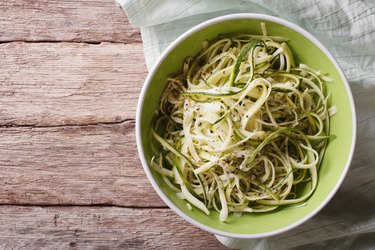
Of all the different diets, the hypocaloric diet is one of the simplest. This diet simply requires eating fewer calories than you burn, allowing you to lose weight.
Tip
A hypocaloric diet focuses on eating fewer calories than you burn in order to lose weight. It’s considered to be one of the most sustainable diet methods for long-term results. To get started, try incorporating lower-calorie foods that are high in nutrients but low in calories.
Video of the Day
With a hypocaloric diet, the focus is mainly on energy in versus energy out. You can achieve a hypocaloric state by eating less and exercising — a strategy recommended by the National Heart, Lung and Blood Institute and other experts for sustainable weight loss and maintenance.
Video of the Day
Is a Hypocaloric Diet Best?
With so many different diets and dietary theories, it can be difficult to know which one to follow for weight loss. The term "hypocaloric foods" seems misleading because it implies there are foods that can help you achieve a negative energy balance -- when really, it's about eating lower-calorie foods. A September 2018 review published in the journal Healthcare points out that some researchers emphasize the role of energy deficit, regardless of macronutrient composition.
Others stress the role of macronutrients irrespective of calorie count. Still others highlight the role of diet quality via naturally cooked, unprocessed foods, regardless of either macronutrients or calories.
The review stresses that the optimal diet to treat obesity should be safe, nutritionally sound, affordable and sustainable. Whether you have a lot or a little weight to lose, it's important to eat a balanced diet tailored to your individual needs, preferences and medical conditions.
One thing that most health and fitness experts can agree upon is that it is not possible to lose weight without a negative energy balance, according to the review. For weight loss to occur, then, energy intake must remain consistently lower than energy output.
Read more: Fatigue While on a Calorie Restricted Diet
Even Modest Weight Loss Helps
Even a modest weight loss of 5 to 10 percent can improve your health, according to the Centers for Disease Control and Prevention (CDC). Lower blood pressure, reduced cholesterol and healthy blood sugar levels are just a few of the benefits of shedding extra weight.
A study published in Translational Behavioral Medicine in September 2016 examined data from 401 adults with overweight and obesity who enrolled in a multi-year behavioral weight loss program. The purpose of the study was to determine whether weight loss of 5 to 10 percent is sufficient to positively impact cardiovascular health.
At the conclusion of the study, participants who lost 5 to 10 percent showed significant reductions in triglycerides, fasting glucose, total cholesterol and low-density lipoprotein (LDL) cholesterol.
Those who lost more than 10 percent experienced significantly greater improvements in triglycerides, total cholesterol and LDL cholesterol. In fact, they improved in all risk factors, except high-density lipoprotein cholesterol.
Read more: The 9 Best Cholesterol-Lowering Foods
Achieve Healthy Weight Loss
Although it's possible to lose weight simply by reducing calories, the 2015-2020 Dietary Guidelines for Americans recommend a healthy eating pattern, accounting for all food groups. Focus on fruits, vegetables, lean proteins, low-fat dairy and whole grains. Limit saturated fats and added sugars to no more than 10 percent of daily calories, and sodium to no more than 2,300 milligrams per day.
In addition, the Dietary Guidelines recommend eating around 45 to 65 percent carbs, 25 to 35 percent fat and 10 to 30 percent protein for your daily calories. This macronutrient profile will provide the greatest nutrition for healthy weight loss.
Some of the following lower-calorie food swaps will help you reduce caloric intake:
- Fat-free or low-fat milk in place of whole milk
- Low-fat yogurt with berries in place of ice cream
- Zucchini or squash "noodles" in place of pasta
- Ground turkey in place of ground beef
- Egg whites in place of whole eggs
- Whole-grain English muffin in place of donuts or bagels
- Broth-based soups in place of canned cream soups
Eating this way will help you lose weight gradually and safely. The CDC notes that weight loss of 1 to 2 pounds a week is a healthy rate. It's also the most sustainable, so you can lose weight and keep it off.
To lose a pound a week, you'll need to create a caloric deficit of 3,500 calories, explains the Mayo Clinic. To create a hypocaloric state, you can combine a lower-calorie diet with exercise.
Aim for at least 150 moderate-intensity or 75 vigorous minutes of physical activity a week, per the Physical Activity Guidelines for Americans. For even greater results, add in strength training twice a week for all major muscle groups. In time, your commitment to healthy living will help you achieve your goal weight.
- National Heart, Lung and Blood Institute: "Maintain a Healthy Weight"
- National Center for Biotechnology Information, U.S. National Library of Medicine: Healthcare: "Defining the Optimal Dietary Approach for Safe, Effective and Sustainable Weight Loss in Overweight and Obese Adults"
- Centers for Disease Control and Prevention: "Losing Weight"
- National Center for Biotechnology Information, U.S. National Library of Medicine: Translational Behavioral Medicine: "Effects on Cardiovascular Risk Factors of Weight Losses Limited to 5–10%"
- Office of Disease Prevention and Health Promotion: 2015-2020 Dietary Guidelines for Americans: "Key Elements of Healthy Eating Patterns"
- Mayo Clinic: "Counting Calories: Get Back to Weight-Loss Basics"
- Office of Disease Prevention and Health Promotion: 2015-2020 Dietary Guidelines for Americans: "Appendix 7. Nutritional Goals for Age-Sex Groups Based on Dietary Reference Intakes and Dietary Guidelines Recommendations"
- U.S. Department of Health & Human Services: "Physical Activity Guidelines for Americans"
Was this article helpful?
150 Characters Max
0/150
Thank you for sharing!
Thank you for your feedback!